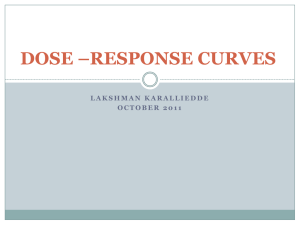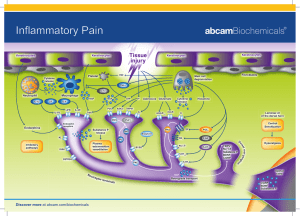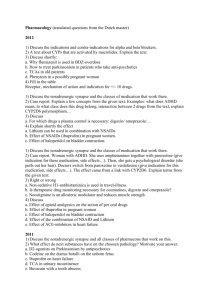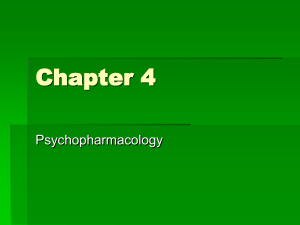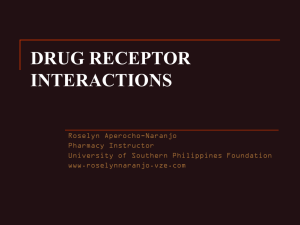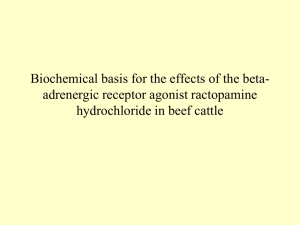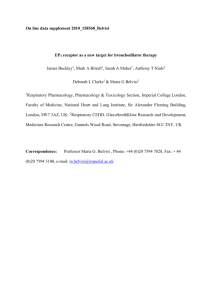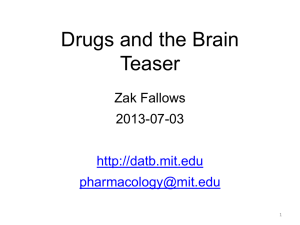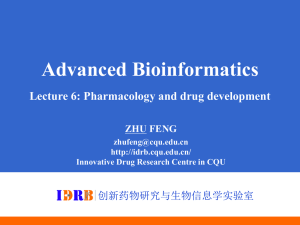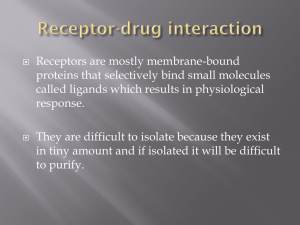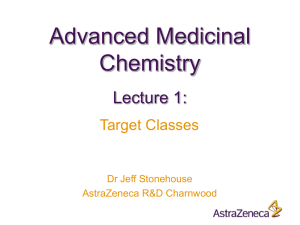Population responses
advertisement
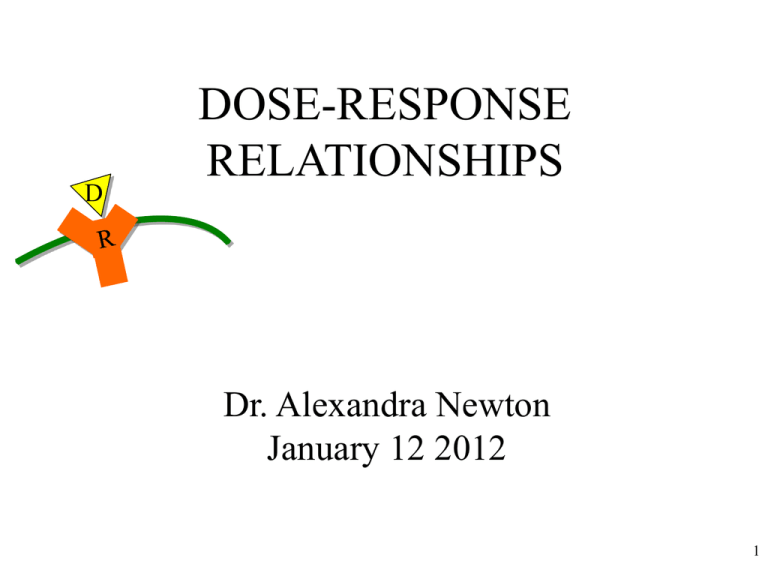
D DOSE-RESPONSE RELATIONSHIPS R Dr. Alexandra Newton January 12 2012 1 Goal To understand dose-response relationships and how these are affected by antagonists Albuterol D Molecular R b2 adrenergic receptor Cellular Organ [cAMP] Human Bronchodilation D+R DR Response Asthma Lecture Outline Dose-Response Relationships 1. Law of mass action and reversible binding 2. Relationship between drug concentration and receptor occupancy 3. Antagonists (competitive and noncompetitive) 4. Population responses D R Law of Mass Action rate constant, units M-1 sec-1 k1 D+R DR Response k-1 rate constant, units sec-1 • D and R associate at rate proportional to both [D] and [R] • DR dissociates at rate proportional to [DR] only • Reversible k1 D+R DR Response k-1 Rate of association = k1[D][R] ← proportional to both [D] and [R] Rate of dissociation = k-1[DR] ← proportional to [DR] only At steady state, rate of association = rate of dissociation k1[D][R] = k-1[DR] k__-1 [D][R] _____ = = Kd [DR] k1 equilibrium dissociation constant units = M Relationship between equilibrium constant and free energy: DG = -RTlnK R=1.98 cal/°mol T=310 °K = 37 °C Lecture Outline Dose-Response Relationships 1. Law of mass action and reversible binding 2. Relationship between drug concentration and receptor occupancy 3. Antagonists (competitive and noncompetitive) 4. Population responses D R Relationship between Drug Concentration and Response or Receptor Occupancy D+R Drug concentration at which drug effect (response) is half-maximal = EC50 DR Response Drug concentration at which receptor-bound drug (receptor occupancy) is half-maximal = Kd Relationship between Kd and Receptor Occupancy Receptor occupancy = fraction of total receptors (RT) occupied by drug (aka fractional saturation) = [DR]/[RT] [DR] [DR] ___ _______ Fractional saturation = [RT] = [R] + [DR] k__-1 [D][R] _____ = = Kd ← When [D] = Kd, [R] = [DR] [DR] and [DR]/[RT] = 0.5 k1 1.0 [DR] ___ [RT] [DR] ___ [RT] log Kd log [D] Agonists 100 Response Full agonist: maximal response Partial agonist: partial response Inverse agonist: decreases basal response 0 0.1 10 [D], nM 1000 Lecture Outline Dose-Response Relationships 1. Law of mass action and reversible binding 2. Relationship between drug concentration and receptor occupancy 3. Antagonists (competitive and noncompetitive) 4. Population responses D R Antagonists aka inhibitors (I) Bind to receptor but do not promote response I+R IR Competitive antagonist I No response Noncompetitive I antagonist D I I I I D I Competitive Antagonist I + Kd D+R DR Ki IR Response Noncompetitive Antagonist I + Kd D+R I + DR Ki D + IR Kd Response Ki IRD Kd remains unchanged Maximum response 1 _______ is reduced 1 + [I]/Ki More Definitions Mixed antagonist: binds to separate site but modulates the ability of agonist to bind Physiological antagonist: a drug (or endogenous mediator) that antagonizes the effect of another drug (or endogenous mediator) by producing an opposing physiological response, typically by a different type of receptor. Example: epinephrine acting at β1 receptors physiologically opposes the decrease in heart rate that occurs in response to acetylcholine acting at M2 receptors Reversible antagonist: reversible binding Irreversible antagonist: irreversible binding (law of mass action not followed) Allosteric activator: binds to site independent of agonist binding site and enhances activity of agonist Allosteric inhibitor: binds to site independent of agonist binding site and reduces activity of agonist Receptor Desensitization Response decreases with time and/or repetitive stimulation Potency and Efficacy Potency refers to the dose that causes a given effect most potent = lowest EC50 least potent = highest EC50 Efficacy refers to the maximum response (effect) most efficacious = largest response least efficacious = smallest response Lecture Outline Dose-Response Relationships 1. Law of mass action and reversible binding 2. Relationship between drug concentration and receptor occupancy 3. Antagonists (competitive and noncompetitive) 4. Population responses D R Quantal Dose-Response Curves ED50 Median effective dose: produces specified effect in 50% of patients LD50 Median lethal dose Therapeutic index = LD50/ED50
